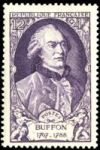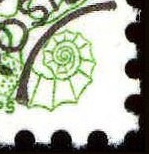the place where Paleontology and Paleoanthropology meets Philately
France
Dinosaurs and other prehistoric animals, fossils, paleontologists, contributor to Paleontology on official and personalized stamps, postmarks and postal stationeries of France
| << previous country | back to index | next country >> |
Contents:
- Country overview
- Philately of France
- Official stamps of France related to Paleontology
- Some personalized stamps of France related to Paleontology
- Other stamps of France to consider
- Some personalized stamps of France to consider
- Post stationeries of France related to Paleontology and Paleoanthropology
- Commemorative covers of France related to Paleontology and Paleoanthropology
- Official covers of the National History Museums of France
- Commemorative postmarks and meter franking of France related to Paleontology
- Postmarks and meter franking with direct connection to Paleontology: dinosaurs and other prehistoric animals, fossils, prehistoric humans, paleontologists
- Postmarks and meter franking of philatelic and fossil trade shows and exhibitions listed separately.
- Other postmarks and meter franking to consider: cave paintings of prehistoric animals, Natural History Museum, flint tools, contributors to Paleontology and Paleoanthropology sciences.
- References
- Acknowledgements
France, officially the French Republic, is a unitary sovereign state comprising territory in western Europe and several overseas regions and territories.
French Southern and Antarctic Territory or Terres australes et antarctiques françaises (TAAF) in French, issued some Paleontology related stamps.
The European part of France, called metropolitan France, extends from the Mediterranean Sea to the English Channel and the North Sea, and from the Rhine to the Atlantic Ocean.
France spans 643,801 square kilometers and has a total population of 66.6 million. It is a unitary semi-presidential republic with the capital in Paris, the country's largest city and main cultural and commercial centre. The Constitution of France establishes the state as secular and democratic, with its sovereignty derived from the people. [R1]
The first stamps of France were issued on 1 January 1849.
Sometimes imperforated French stamps are offered by some dealers, especially on the Internet. These stamps are printed in very small quantities and offered to the authorities (Postmaster General, Minister's office, prefects, designer of stamp, etc.). And sometimes these authorities sell them to traders who, themselves, sell them to collectors. These imperforated stamps are not valid for postage and cannot be used for franking letters. [R2]
According to Michel-online catalog, since beginning of this century, Post of France increased amount stamps issued a year significantly. Over 400 (!) stamps were issued in 2016 and 2018 for example.
However, unlike many other countries who issue excessive numbers of stamps per year, French stamps are well-designed, high quality and exhibit topics of French culture and history.
Official stamps of France related to Paleontology: dinosaurs and other prehistoric animals, fossils, prehistoric humans, paleontologists
| 10-17.05.1969 "Famous persons" [1] | 15.10.1977 "100th anniversary of Abbe Breuil" | 23.05.1981 "100th anniversary of Pierre Teilhard de Chardin" |
 |
 |
 |
| 20.6.1992"Tautavel Man" [2] | 17.06.2000 "Natural History Museum" [3] | 21.08.2008 "Prehistoric animals" |
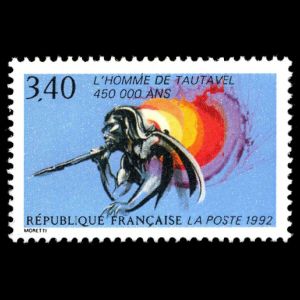 |
 |
 |
| 01.06.2010 "Institute of Human Paleontology" [4] | 04.01.2014 "Dynamic" [5] | 05.01.2018 "Works of Nature" [6] |
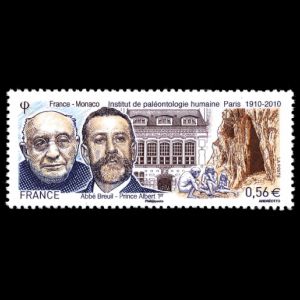 |
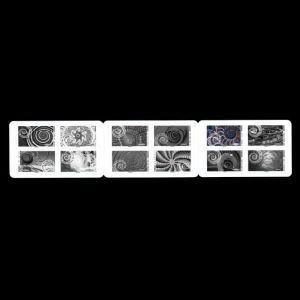 |
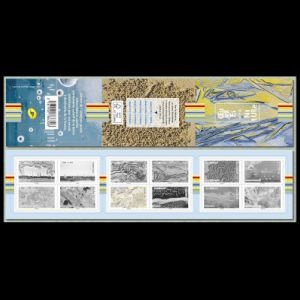 |
| 24.06.2024 "50 years of the discovery of Lucy" | ||
 |
|
|
Notes:

|
| Georges Cuvier on stamp of France 1969, MiNr.: 1673, Scott: B430 |
The pink stamp shows Georges Cuvier (1769-1852), who was a French naturalist and zoologist, sometimes referred to as the "Father of Paleontology".
[2] Tautavel Man, an early hominid and some of the oldest human remains in Europe, was found in Caune de l'Arago, a cave in Tautavel commune in France. Tautavel Man (Homo erectus tautavelensis) is a proposed subspecies of Homo erectus, the type specimen being 450,000-year-old fossil remains discovered in the Arago Cave at Tautavel, France. Excavations began in 1964, with the first notable discovery occurring in 1969. All fossils recovered from Arago were found by Henry and Marie-Antoinette de Lumley and are now located at the Institute for Human Palaeontology in Paris. [R3]
[3] The Natural History Museum in Paris is one of the oldest Natural History Museums in the world and has a very extensive fossil collection of prehistoric humans and prehistoric animals, include dinosaurs. One of the dinosaurs is depicted on stamp from 2000. [R4]
[4] Joint issue with Monaco

Institute of Human Paleontology on stamp of France 2010, MiNr.: 4870, Scott: 3821. Institute of Human Paleontology on stamp of Monaco 2010, MiNr.: 3000, Scott: 2597.
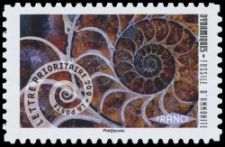
|
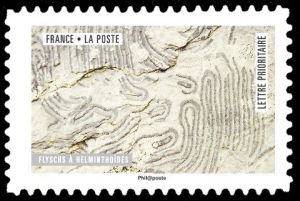
|
| Ammonite on stamp of France 2014, MiNr.: 5752l, Scott: 4541 | Helminthoides Flysch on stamp of France 2018, MiNr.: 6935, Scott: 5365 |
Dynamic lines, swirling movement of life, in nature, in construction, in craft in art. The booklet highlights the mystery of motion, especially that of the spiral. One of these stamps depicts an Ammonite.
[6] Booklet of 12 self-adhesive stamps "Works of Nature".
One of the stamps shows "Helminthoides Flysch".
Helminths are parasitic worms. The term helminth does not correspond to a specific zoological category.
"Helminthoides" or "helminthoid" refers to a category of deep sea trace fossils with a characteristic tight meandering pattern. Traces of this sort are now placed in the several different ichnogenera including Nereites, Helmthinopsis, Helminthoida, etc.
"Flysch" refers to a kind of sedimentary rock succession deposited in deeper water settings adjacent to a rising mountain system.
So, "Helminthoides Flysch" or "Helminthoid Flysch" is a term for flysch deposits that contain a specific assemblage of deep water trace fossils.
These types of traces are usually at the top of the layer of sediment – instead of burrowing down into the sediment, they shifted material around at the sea floor. [R5]
Some personalized stamps related to Paleontology: dinosaurs and other prehistoric animals, fossils, prehistoric humans, paleontologists
| 11.05.2008 "House of Marble and Geology at Rinxent" | xx.xx.2010 "Prehistory museum in Quinson" [SP1] | 23.11.2011 "Neanderthals of Saint Césaire" [SP2] |
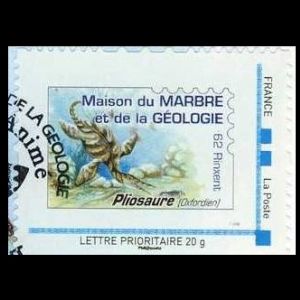 |
 |
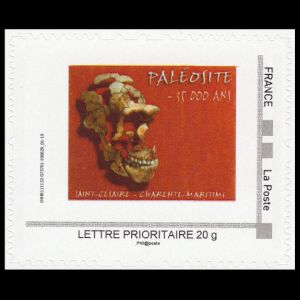 |
| 09.12.2014 "100th anniversary of Saturnin Garimond" | 19.05.2016 "89th Congress of the FFAP" [SP3] | 02.02.2018 "150th anniversary since death of Jacques Boucher de Crèvecœur de Perthes" |
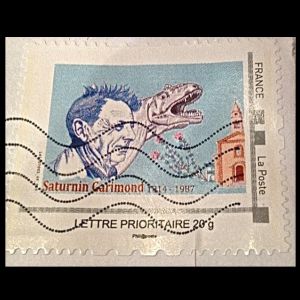 |
 |
 |
Fossils of Lebanon on personalized stamps of France [SP4]
| 01.10.2016 "Insect Fossils of Lebanon" | 01.10.2017 "Insect Fossils of Lebanon" | 01.10.2018 "Insect Fossils of Lebanon" |
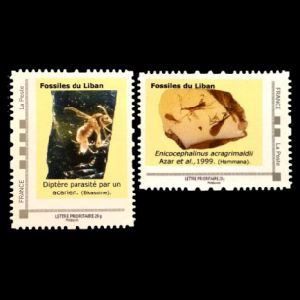 |
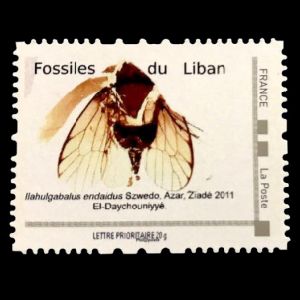 |
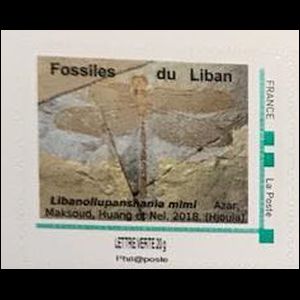 |
| 01.10.2019 "Fossils of Lebanon" | 01.10.2020 "Insect Fossils of Lebanon" | 15.10.2021 "Fossils of Lebanon" |
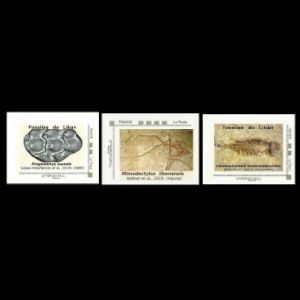 |
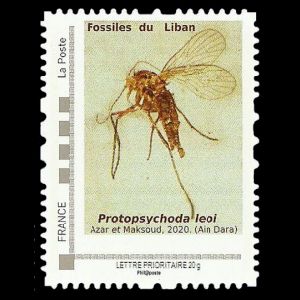 |
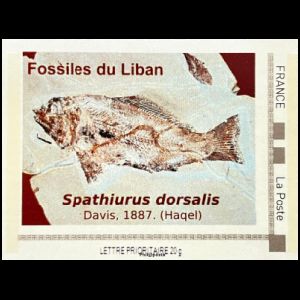 |
Notes:
[SP1] Prehistory museum in Quinson — one of the largest prehistoric museums in Europe.
Many fossils of prehistoric humans and animals, dated 400.000 years ago, were found in a cave 35 kilometers east of Cadarache in Provence region of France. This is one of the earliest examples of an organized prehistoric habitat of prehistoric man found in Europe. Since the first settlements there, the cave has been home to various populations: pre-Neanderthals and Neanderthals, Homo Sapiens, Bronze Age groups, Neolithic herdsmen and Gallo-Roman communities. [R6]
[SP2] A neanderthal found at Saint Cesaire is shown on a personalized stamp. The specimen is now known as la Pierrette, since it is now believed to be female. [R7]
[SP3] This Mini-Sheet was on sale between May 19 to 22 at Paris by Phil@poste for the French Federation of Philatelic Associations (FFAP) during the stamp show "La passion du timbre : Paris-Philex" and the 89th Congress of the FFAP. The stamp is a personalized one (1st national domestic rate); a Dinosaur skeleton, perhaps Tyrannosaurus rex, a gastropod fossil from the Tertiary (Turitella sp.), a cut amethyst crystal and Buffon's statue (located in the botanical garden of the Natural History Museum at Paris) are on the margin.
[SP4] Since 2016, Professor Dany Azar of the Lebanese University has issued personalized stamps using the French Post.
These stamps depict fossils of Lebanon. These personalized stamps have been regularly issued in October every year for International Fossil Day and for the the International Fossil Insects Day. For more details please click here.
Other stamps to consider: Cave painting of prehistoric animals, contributors to Paleontology science, Natural History Museuems
| 14.11.1949 "Famous persons" [A1] | 15.06.1957 "Famous persons" [A2] | 13.04.1968 "Cave painting of Lascaux cave" |
 |
 |
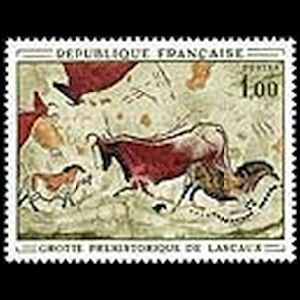 |
| 17.01.1978 "The Signs of the Zodiac" [A3] | 17.07.1979 "Tourism" | 12.01.1981 "Historical Constructions" [A4] |
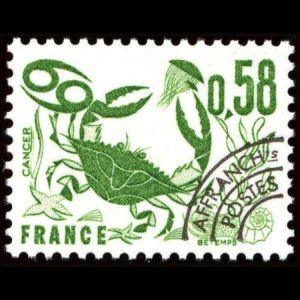 |
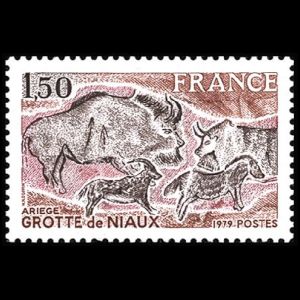 |
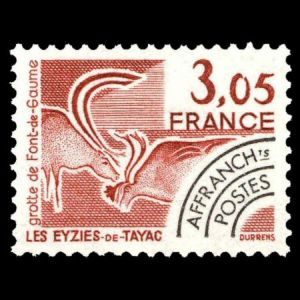 |
| 05-06.1993 "200th anniversary of Natural History Museum in Paris" | UNESCO-France 20.10.1993 "Tassili National Park of Algeria" |
27.05.2006 "50 years since discovery of cave painting of prehistoric animals of Grotte de Rouffignac" |
 |
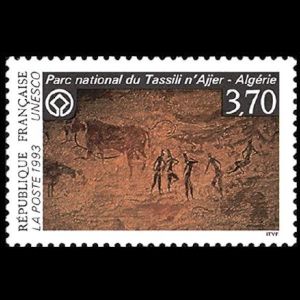 |
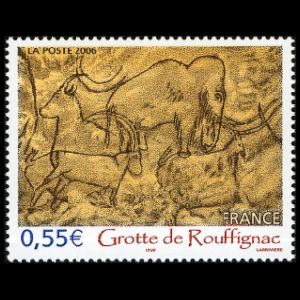 |
| 29.04.2019 "Painting from Lascaux Cave" [A5] | 17.07.2023 "The Route Napoléon" [A6] | |
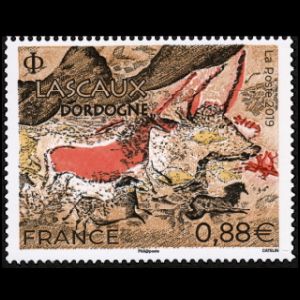 |
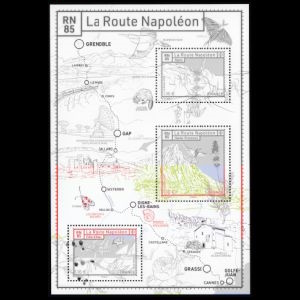 |
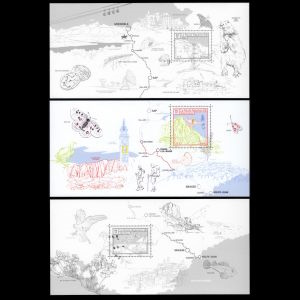 |
| 07.11.2024 "Chauvet cave - Ardeche" [A5] | ||
 |
|
|
Notes:
[A1] Georges Buffon (1709-1788) depicted on stamp with face value of 12+4F.
He envisioned the nature of science and understood the roles of paleontology, zoological geography, and animal psychology.
More details are here
[A2] Bernard Palissy (1510–1589) depicted on stamp with face value of 12+3F.
Palissy is known for his contributions to the natural sciences, and is famous for discovering principles of geology, hydrology and fossil formation. He was one of the first Europeans to enunciate the correct theory of the origin of fossils.
More details are here
[A3] During 1977 and 1978 (01.04.1977, 17.01.1978, 01.07.1978) Post of France issued the set Zodiac definitive stamps. Each time 4 stamps are printed. Ammonite was depicted on the right buttom corner of the Crab stamp.
[A4] Part of set of 4 stamps
[A5] Painting from Lascaux Cave.
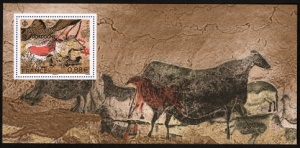
|
| Prehistoric anmals on paintig at Lascaux Cave on stamp of France 2019 MiNr.: Bl. 434 (7306C), Scott: |
The stamp issued in sheets of 30 as well as a souvenir block.
Over 600 parietal wall paintings cover the interior walls and ceilings of the cave. The paintings represent primarily large animals, typical local and contemporary fauna that correspond with the fossil record of the Upper Paleolithic time. The drawings are the combined effort of many generations, and with continued debate, the age of the paintings is estimated at around 17,000 years (early Magdalenian). Lascaux was inducted into the UNESCO World Heritage Sites list in 1979, as element of the Prehistoric Sites and Decorated Caves of the Vézère Valley. [R9]
[A6] An Ammonite - symbol of the geological nature reserve of Haute-Provence - shown on the middle of the Souvenir-Sheet.
For more details, please click here.
Some personalized stamps of France to consider: insect in amber, cave painting
| 30.05.2014 "Bees - that's life" [PA1] | ||
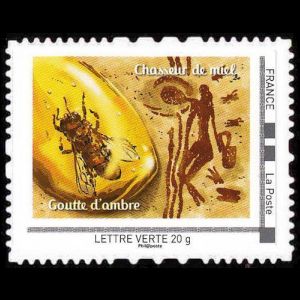 |
|
|
Notes:
[PA1] The Bee on the left side is not prehistoric but modern specie: Apis mellifera and used just for illustration purpose together with a painting from the Cuevas de la Araña, Spain, which shows a Palaeolithic human who gathering some honey from wild bees.
Post stationery of France related to Paleontology and Paleoanthropology
| 2006 | ||
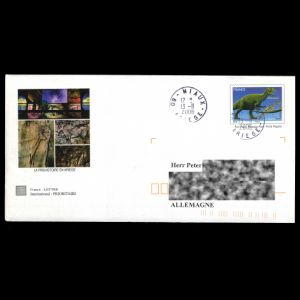 |
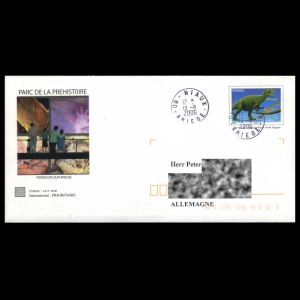 |
 |
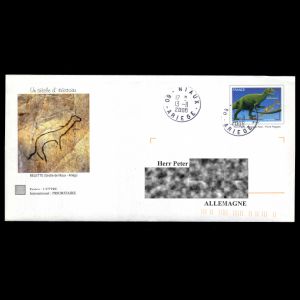 |
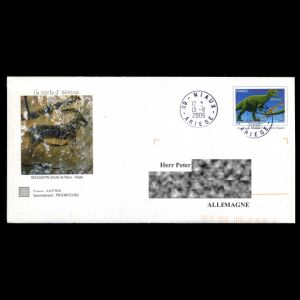 |
|
Personalized postal stationeries: standard postal stationeries with customized cachets, printed by some museums, societies or dealers.
Only few such covers are listed below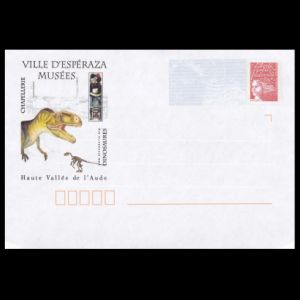 |
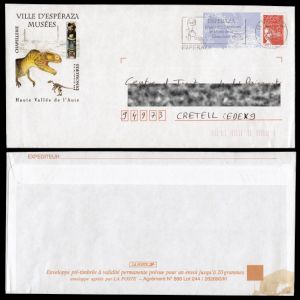 |
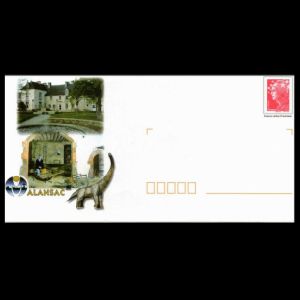 |
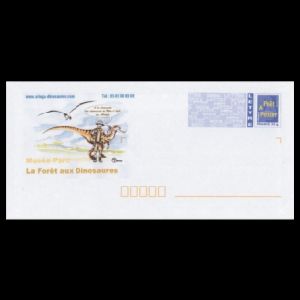 |
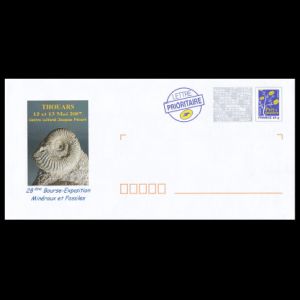 |
 |
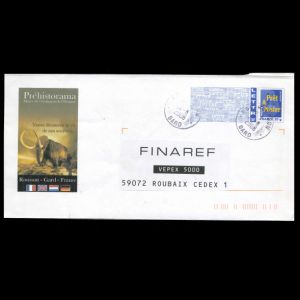 |
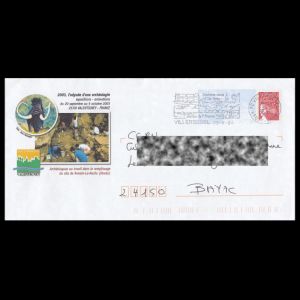 |
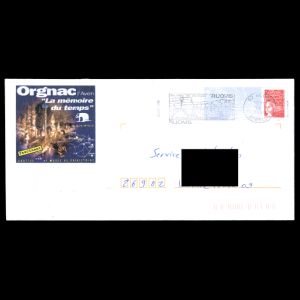 |
 |
 |
 |
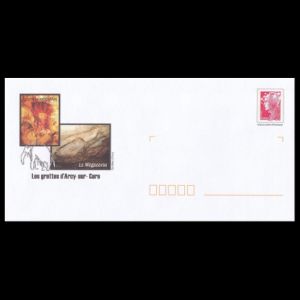 |
|
|
Commemorative covers of France related to Paleontology and Paleoanthropology: prehistoric animals on the cachets
 |
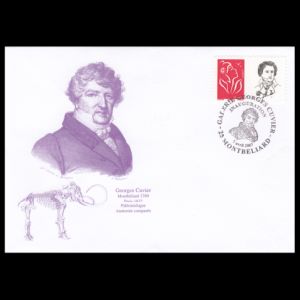 |
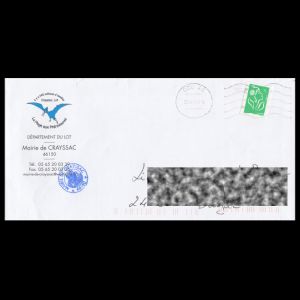 |
 |
|
|
Official covers of the National History Museums of France
| The Institute of Human Paleontology, Paris, France 1913 | National Museum of Natural History, Paris, France 2009 | |
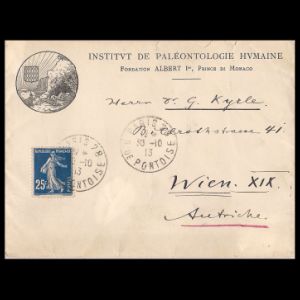 |
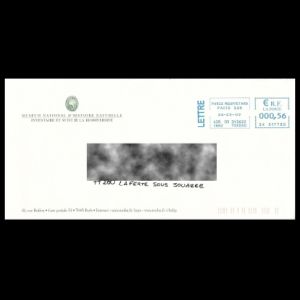 |
|
Commemorative postmarks, advertising cancellations (in French “flammes d’oblitération”) and meter franking of France related to Paleontology.
- Postmarks and meter franking with direct connection to Paleontology: dinosaurs and other prehistoric animals, fossils, prehistoric humans, paleontologists are below
- Postmarks and meter franking of philatelic and fossil trade shows and exhibitions listed separately.
- "Another postmarks and meter franking to consider" cave paintings of prehistoric animals, Natural History Museum, flint tools, contributors to Paleontology and Paleoanthropology sciences, Jean Baptist Lamarck for example. Postmarks of cave painting with modern animals are ignored.
| 1969 - 2005 "Villers sur Mer, La Cote Fleurie" [PM] [DU] [C1] | 17.05.1969 "200th anniversary of Georges Cuvier" [FDC] | 31.07-04.08.1971 "Centenary of Edouard LARTET" [Sp] |
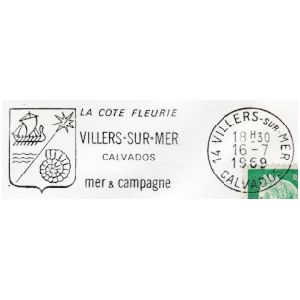 |
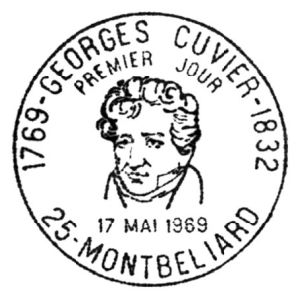 |
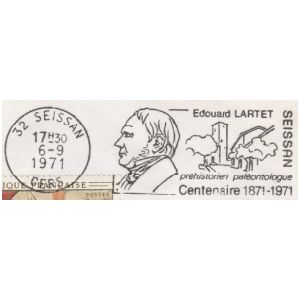 |
| 1976 [DU] "IX congress international union prehistoric and protohistoric sciences in Nice, 13-18 September 1976" [Sp] | 12.09-18.09.1976 "IX congress international union prehistoric and protohistoric sciences in Nice" [Sp] | 23.04.1977 "Centenary of JEAN. Bouyssonie, who discovered the Man from La Chapelle aux Saints in 1908" [Sp]- |
 |
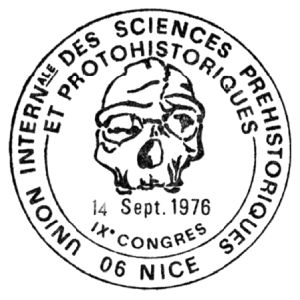 |
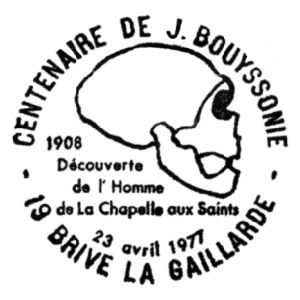 |
| 23.05.1981 "Pierre Teilhard de Chardin" [FDC] [5] | 1981 [DU]- 1991 "Museum of Prehistory Tautavel" [PM] [C2] | 1982 [DU] - 2001 "200.000 years of BIACHE ST VAAST" [PM] |
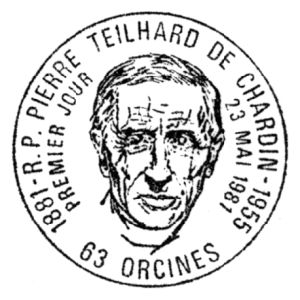 |
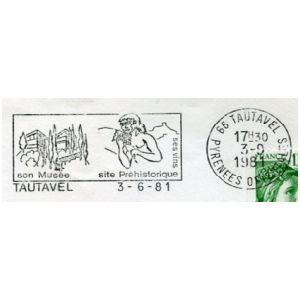 |
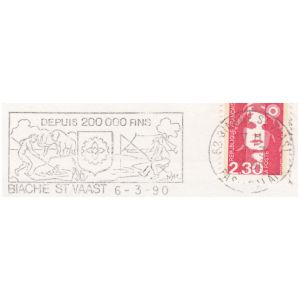 |
| 28.09.1982 "1st
international congress of human paleontology in Nice" |
03.08.1985 "450.00 years of Tautavel man" [Sp] [2] | 13.06.1987 "Opening of Fleury dinosaur museum" [C4] |
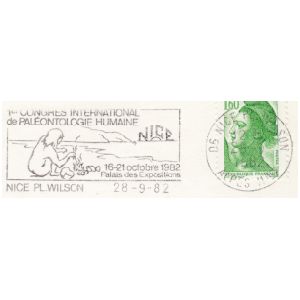 |
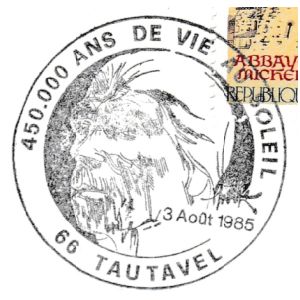 |
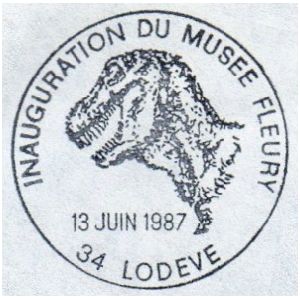 |
| 1987 - 1988 "Geologic Reserve DE LORRAINE" [PM] | 07.11.1987 "Association Nantaise Stones and Fossil" [Sp] | 05.10.1988 "200th anniversary of Boucher de Perthes" [Sp] |
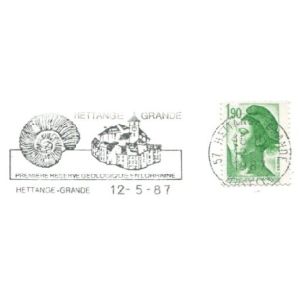 |
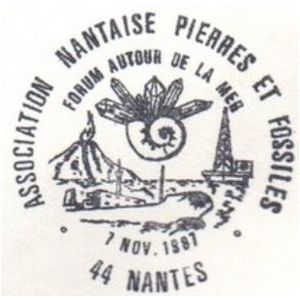 |
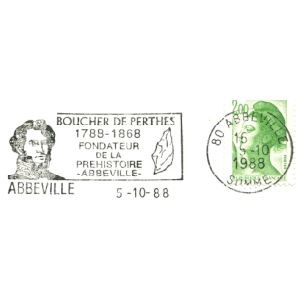 |
| 06.10.1988 "200th anniversary of Boucher de Perthes" [Sp] | 14.03.1989 "200th anniversary of Georges Cuvier" [Sp] | 11.06.1989 "200th anniversary of Georges Cuvier" [Sp] |
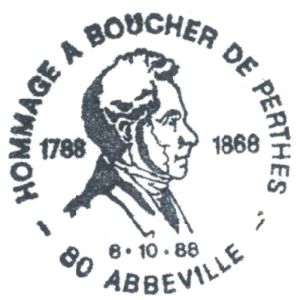 |
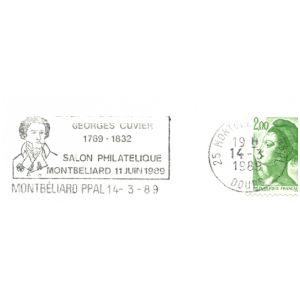 |
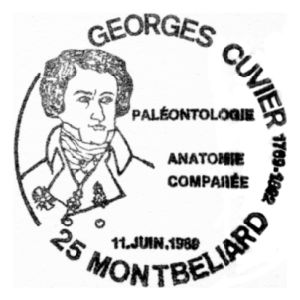 |
| 1989 - 2007 "Thouars history and prehistory" [PM] | 1990-2008 "Geological reserve de HTE Provence" [Sp] | 28.08.1990 "Neanderthal from La-Chapelle-aux-Saints" [Sp] |
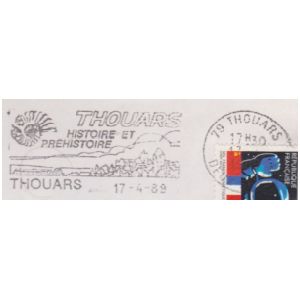 |
 |
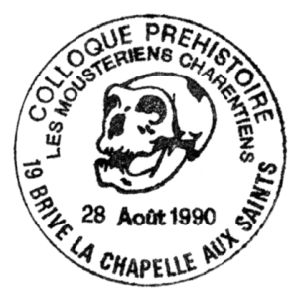 |
| 20.06.1992 "Prehistoric man of Tautavel" [FDC] [2] | 08.07.1992 "Tautavel Museum" - |
21-22.11.1992 "Prehistoric man of Tautavel" [Sp] [2] - |
 |
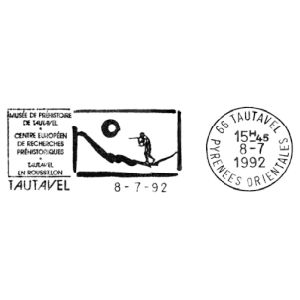 |
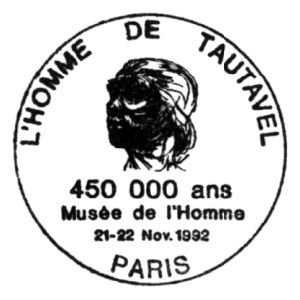 |
| 1990-1999 "Nolay in 225 million years" [PM] | 1993-1996 "Geologic Reserve DE LORRAINE" [PM] [N] | 1993-1996 "Fleury Museum" [PM] [C4] |
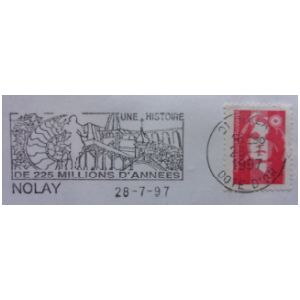 |
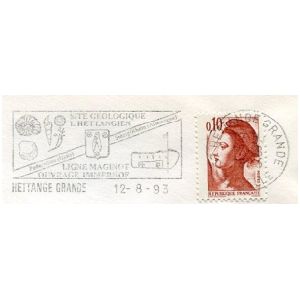 |
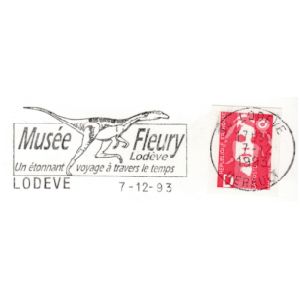 |
| 27.01.1994 "3rd Amiens Archeology Film Festival" [Sp] | 1996 -2006 "Fossil museum in Faluns" [PM] | 1998 - 2000 "Dinosaur museum in Esperaza" [PM] |
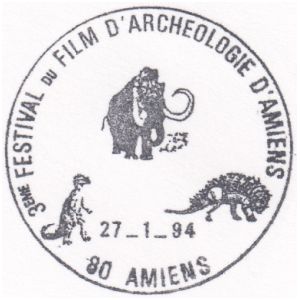 |
 |
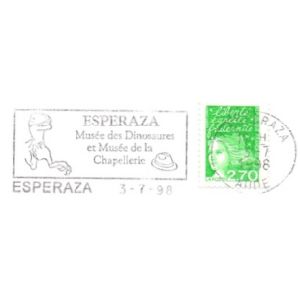 |
| 22-23.12.1999 "Polar expedition of Mammoth" [Sp] | 17.06.2000 "Allosaurus" [FDC] | 19.05.2001 "Allosaurus" [Sp] |
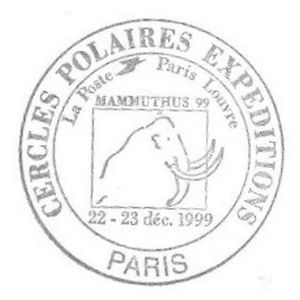 |
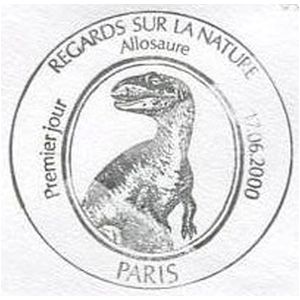 |
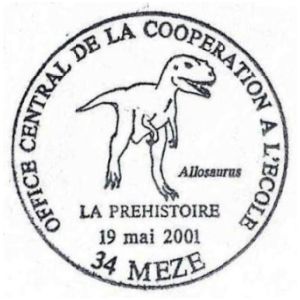 |
| 16.06.2001 "Mammoth expedition" [Sp] - |
2001 "Tourist department of Privas" [Sp] - |
2004 "Tourist office at Villers sur Mer" [Sp] |
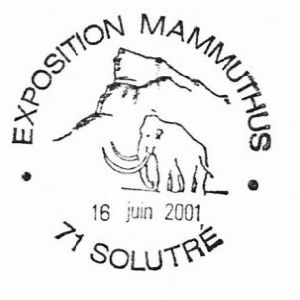 |
 |
 |
| 2006"Cro-Magnon man" - |
07.04.2007 "Open gallery of Georges Cuvier in Montbeliard" [Sp] | 19.04.2008
"Prehistoric
animals" [FDC] - |
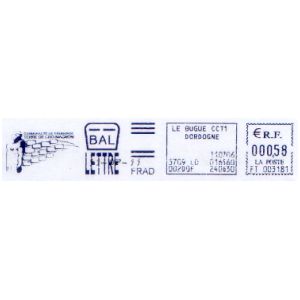 |
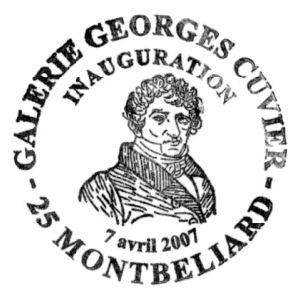 |
 |
| 19.04.2008
"Prehistoric
animals" [FDC] - |
||
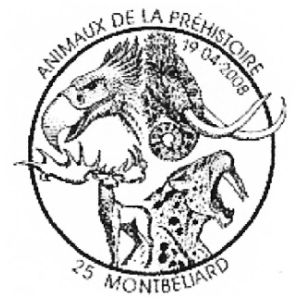 |
 |
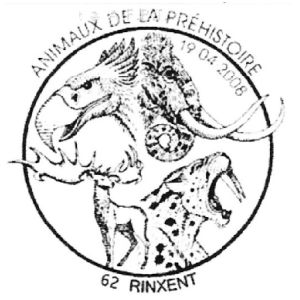 |
| 1.05.2008 "House of Marble and Geology in Rinxent" [Sp] | 22.07.2008 "Tautavel man" [Sp] | 01.06.2010 "Institut de paleontologie humaine" [FDC] |
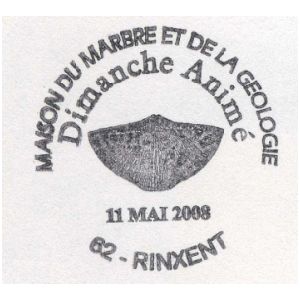 |
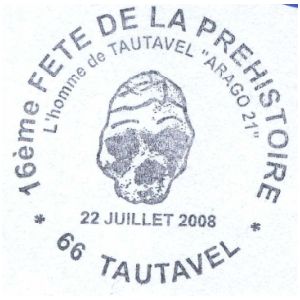 |
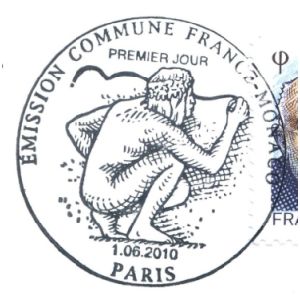 |
| 17.05.2014 "50th
anniversary of philatelic society in Deigne les Bains" [Sp] - |
22.07.2014 "50 anniversary of Tautavel men discovery" [Sp] | 09.12.2014 "100 anniversary of Saturnin Garimond" [Sp] |
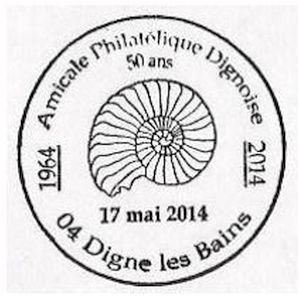 |
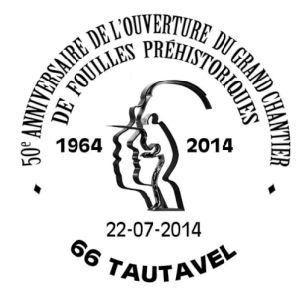 |
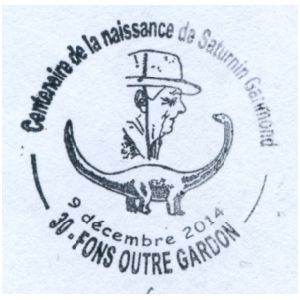 |
| 02.02.2018 "150 anniversary since death of Jacques Boucher de Crèvecœur de Perthes" [Sp] | 20.10.2019 "250th anniversary of Georges Cuvier" [Sp] | |
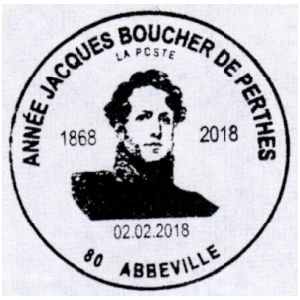 |
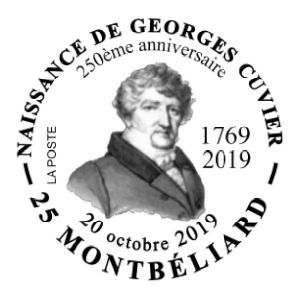 |
|
| 24.06.2024 "50 years of the discovery of Lucy" [FDC] | ||
 |
 |
|
Commemorative postmarks and meter franking issued for Fossil & Mineral trade shows and philatelic exhibitions
| 1979-1980 "4th Mineral and Fossils exhibition show in Bourgogne" [Sp] - |
1980 "Mineral and Fossils exhibition in Saint Nazaire" [Sp] - |
1980 "10th international Mineral and Fossils trade show in Colmar" [Sp] |
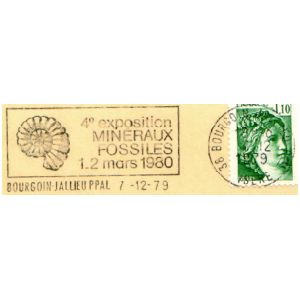 |
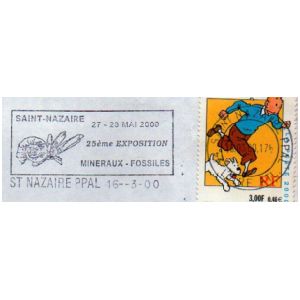 |
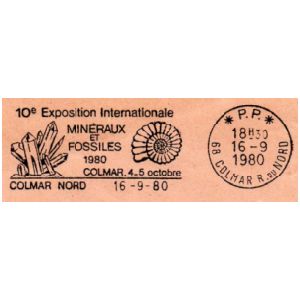 |
| 1983 "6th biennial Mineral and Fossils exhibition in Bordeaux" [Sp] | 10-11.12.1983 "6th biennial Mineral and Fossils philatelic exhibition in Bordeaux" [Sp] | 1984 "3rd biennial Mineral and Fossils exhibition in Thionville" [Sp] - |
 |
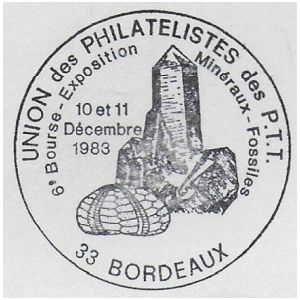 |
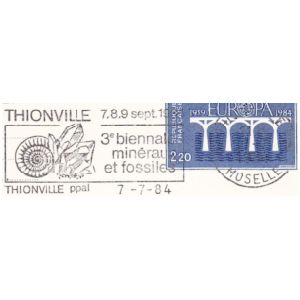 |
| 1984 "7th Mineral and Fossils exhibition in Bordeaux" [Sp] | 08.09.1984 "3rd biennial Mineral and Fossils exhibition in Thionville" [Sp] - |
07.11.1984 "7th Mineral and Fossils philatelic exhibition in Bordeaux" [Sp] |
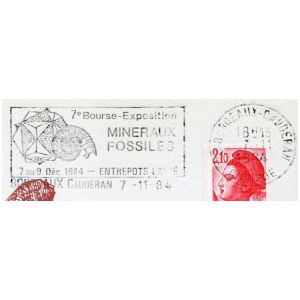 |
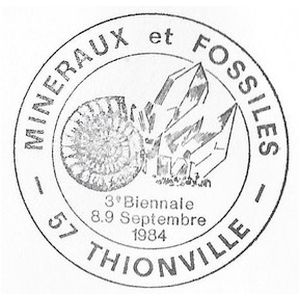 |
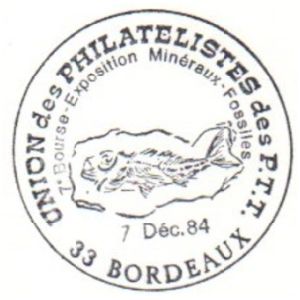 |
| 1984 "5th international Mineral and Fossils exhibition in Blagnac" [Sp] - |
1984 "Mineral and Fossils exhibition in Capbreton" [Sp] - |
1984 "Mineral and Fossils stamp show in Gironde" [Sp] |
 |
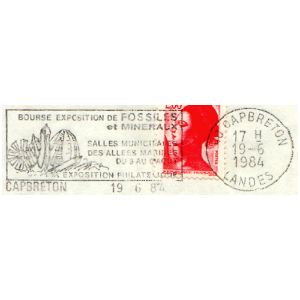 |
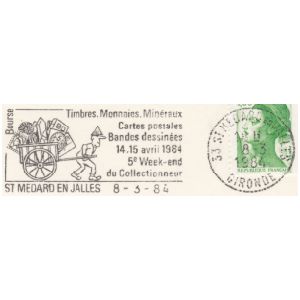 |
| 1986 "9th Mineral and Fossils exhibition in Poitiers" [Sp] | 1987 "10th Mineral and Fossils exhibition in Poitiers" [Sp] | 1987 "Minerals and Fossils exhibition in Dijon" [Sp] |
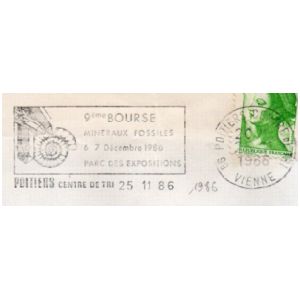 |
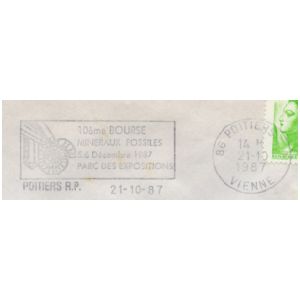 |
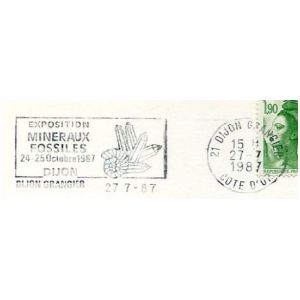 |
| 1987 "Minerals and Fossils exhibition in Nantes Rollin" [Sp] | 1988 "14th Minerals and Fossils exhibition in Blois Gare" [Sp] | 1988 "Minerals and Fossils exhibition in Dijon" [Sp] |
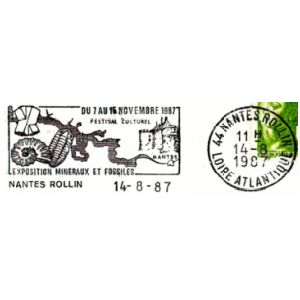 |
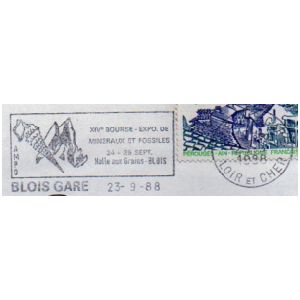 |
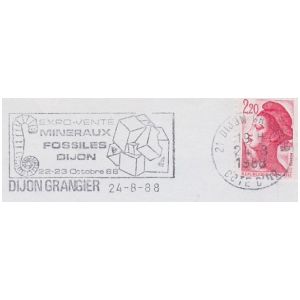 |
| 1988 "3rd Fossil and Mineral exhibition in Rennes Republique" [Sp] | 1988 "13th Fossil and Mineral exhibition in Grenoble" [Sp] | 09.10.1988 "Exhibition Philately and Mineralogy" [Sp] |
 |
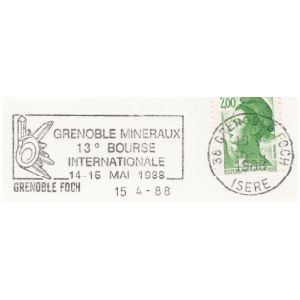 |
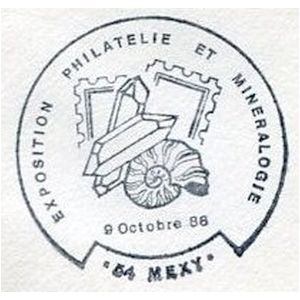 |
| 1989 "Minerals and Fossils trade show in Dijon" [Sp] | 1989 "12th Minerals and Fossils exhibition in Surgeres" [Sp] | 1990 "13th Minerals and Fossils exhibition in Surgeres" [Sp] - |
 |
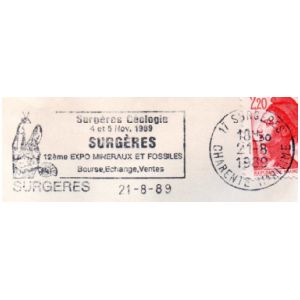 |
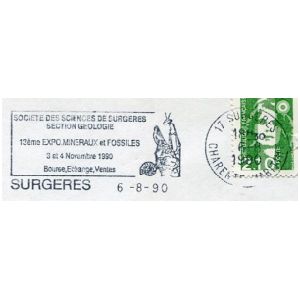 |
| 1990 "3rd Minerals and Fossils exhibition in Valognes" [Sp] | 1990 "15th Fossil and Mineral exhibition in Grenoble" [Sp] | 1992 "10th Mineral and Fossils exhibition in Thionville" [Sp] |
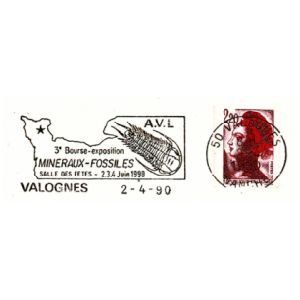 |
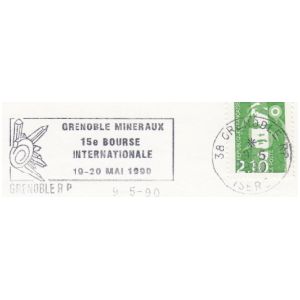 |
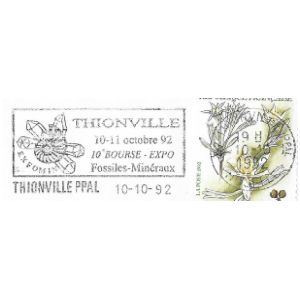 |
| 1993 "18th Mineral and Fossils exhibition in Nancy" [Sp] | 07.11.1993 "Philatelic exhibit in Bernay" [Sp] | 16-17.04.1994 "52nd Regional Philatelic congress in Champagnole" [Sp] |
 |
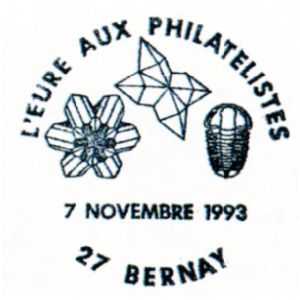 |
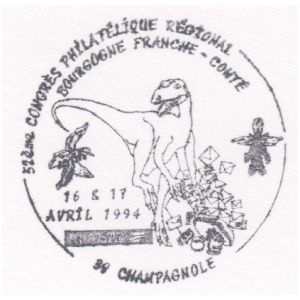 |
| 1994 "Philatelic show Fossils of France" [Sp] - |
1997 "22nd Minerals and Fossils trade show in St. Nazaire" [Sp] | 26-27.04.1997 "55th Regional Philatelic congress in Montceau les Mines" [Sp] |
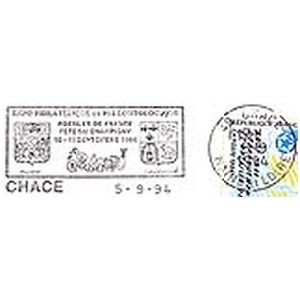 |
 |
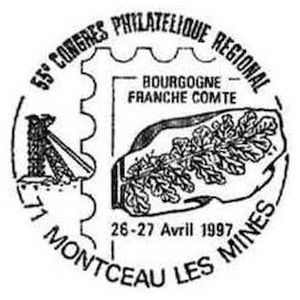 |
| 07-08.10.2000 "19th Minerals and Fossils exhibition in Nantes" [Sp] | 2000 "25th Minerals and Fossils exhibition in St. Nazaire" [Sp] | 2001 "26th Minerals and Fossils exhibition in St. Nazaire" [Sp] |
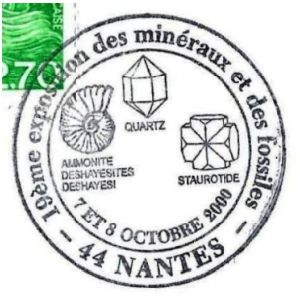 |
 |
 |
| 12-13.05.2007 "28th Minerals and Fossils exhibition in Thouars" [Sp] | 2008 "Paleomania exhibition" [Sp] - |
|
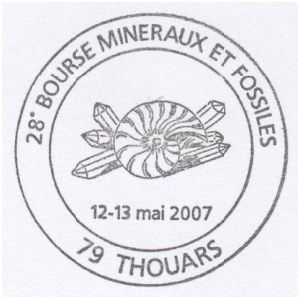 |
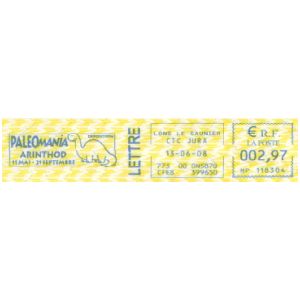 |
|
Some other postmarks to consider: cave painting, buildings of Natural History Museums, flint tools, contributors to Paleontology and Paleoanthropology
| 16.06.1957 "250 anniversary of Georges Buffon" [Sp] | 1960-1962[DU] "Lascaux Cave" [PM] | 1962-1972[DU] "Lascaux Cave" [PM] |
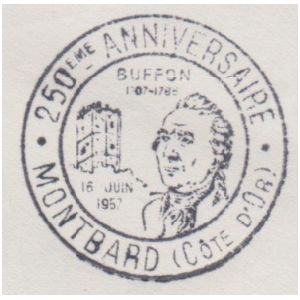 |
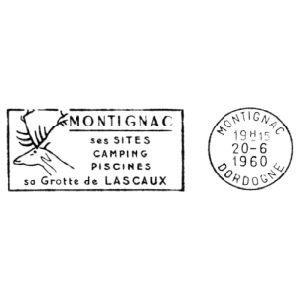 |
 |
| 1963-1965[DU] "Centenary of prehistory in Perigord" [PM] | 1963-1983[DU] "LES EYZIES high place of prehistory" [PM] | 1965-1975[DU] "Rouffignac the center of prehisttory" [Sp] |
 |
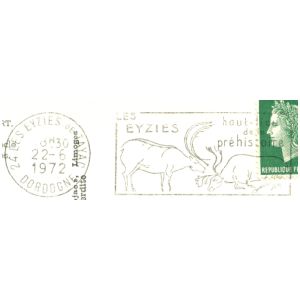 |
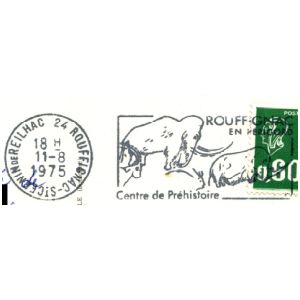 |
| 1967-1999[DU] "Grotte de Niaux" [PM] | 13.04.1968 "Lascaux Cave" [FDC]
| 27.05.1979 "150th anniversary of death Jean Baptist Lamarck" [Sp] |
|
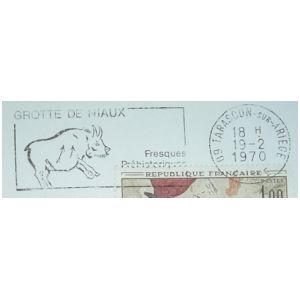 |
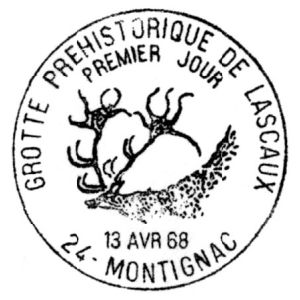 |
 |
| 1981-2006[DU] "FLAMME ART PREHISTORY CENTER ON MARIANNE LUQUET" [PM] | 11.03.1982-1986[DU] "Cave painting at Les Eyzies" [PM] | 26-26.04.1986 "Ppt Recreation Association Forum" [Sp] |
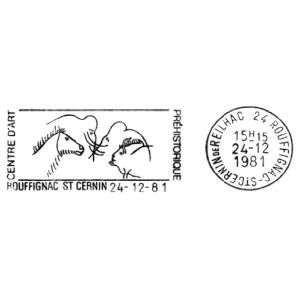 |
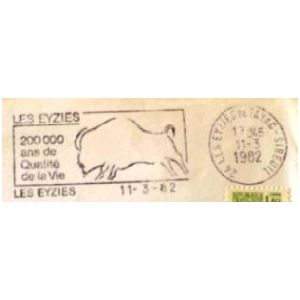 |
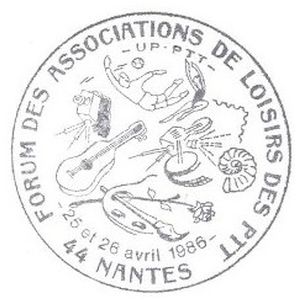 |
| 1988-1999[DU] "Menat city - a unique paleontological site in Europe" [Sp] | 04.11.1989 "Jean Baptist Lamarck" [Sp] | 13.06.1991 "1st International Symposium on the Protection of Geological Heritage" [Sp] |
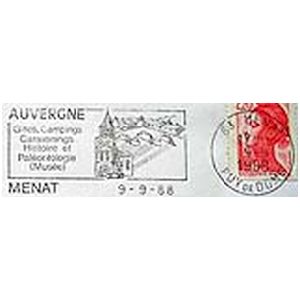 |
 |
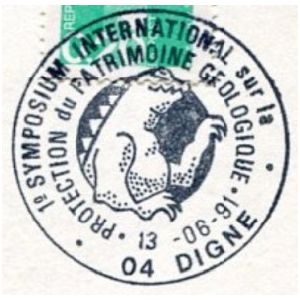 |
| 05.06.1993 "200th anniversary of Natural History Museum in Paris" [FDC] - |
19.11.1994 "Archeological club of Valence" [Sp] - |
1998 "National Museum of Natural History" [Sp] - |
 |
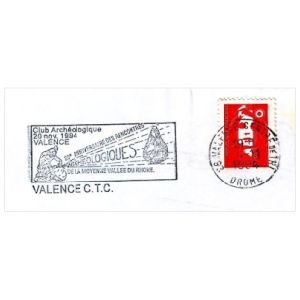 |
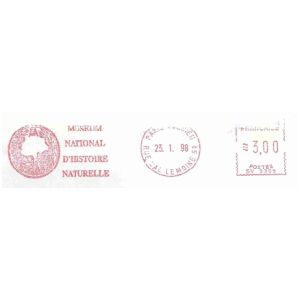 |
| 13.03.1999 "Fossils and Shells exhibition in Jalons" [Sp] | 1999 "Institute of Evolutionary Science of Montpellier" [PM] C5 | 2000 "Domerat" [Sp] |
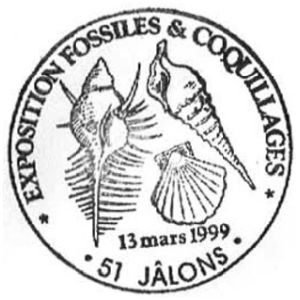 |
 |
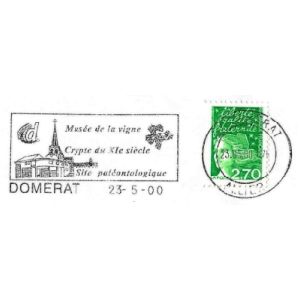 |
| 2003 "Prehistory museum of Les Eyzies de Tayac" [PM] - |
18.08.2005 "150th anniversary of Natural History Museum of Reunion" [Sp] | 19-20.03.2005 "Flint arrowhead" [Sp] - |
 |
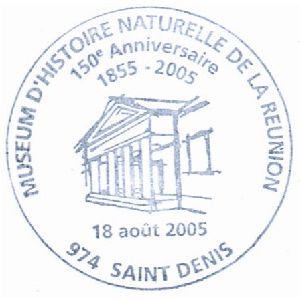 |
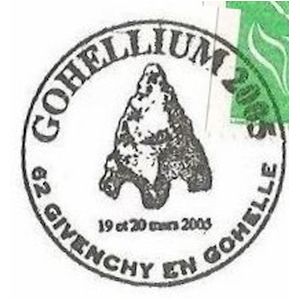 |
| 07.03.2006 "Grotte de Rouffignac" [FDC] | 2008 "Domerat" [PM] | 23.11.2010 "Prehistory museum in les Eyzies" [Sp] |
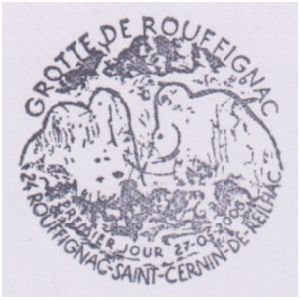 |
 |
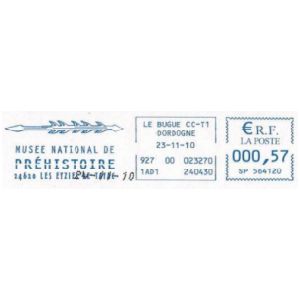 |
| 15.05.2017 "Prehistory museum in les Eyzies" [Sp] | 07.11.2024 "Chauvet cave - Ardeche" | |
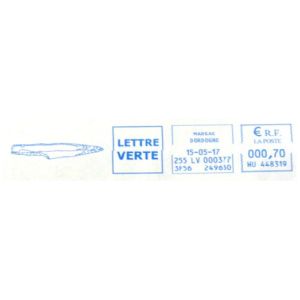 |
 |
 |
Notes:
[C1] Villers-sur-Mer is well known in France for the many fossils found there. The fossils include both marine fossils such as ammonites and Ichthyosaurus and terrestrial animals like dinosaurs.
Many of these fossils can be seen at "Paleospace" museum, that opened its doors in 2011.
[C2] The Museum of Prehistory of Tautavel European Center of Prehistory. It is a complex built around the Man of Tautavel. It presents the history of humanity in Europe from the first Europeans to the gates of history. A reconstruction of Tautavel man is shown on French stamp in 1992 as well on several postmarks and commemorative covers.
[C3] A 180,000 year old paleolithic site was discovered there in April 1976, during construction of an Usinor metallurgical plant. At the site, the remains of two individual Neanderthals with two incomplete skulls were found.
[C4] The museum of Lodève (formerly called Fleury museum) is a museum of modern art, archeology, paleontology and natural sciences located in Lodève (Hérault), in the former mansion of Cardinal Hercules Fleury since 1987. The museum officially opened in 1962, but did not occupy certain areas of the Fleury Hotel until 1972. The museum's collections were essentially enriched by donations, like those of Jacques Audibert and Alice Dardé. The museum focuses its conservation and dissemination efforts on works of art as well as palaeontological and archaeological pieces. [R8]
[C5] Institute of Evolutionary Science of Montpellier (ISEM), is a research institution focusing on biodiversity origins, dynamics and the associated evolutionary mechanisms and processes. [R10]
References:
- [R1] France: Wikipedia WikiTravel FlagCounter
- [R2] Postal History and Philately of France:
Wikipedia
Links to official website of the Post Authority, stamp catalog and a list of new stamps of France are here - [R3] Tautavel Man: Wikipedia
- [R4] Natural History Museum in Paris: fossils collection
- [R5] Helminthoides Flysch: Wikipedia (Parasitic worm), Wikipedia (Flysch),
- [R6] Prehistory museum in Quinson: iter.org (the article does not exist anymore) museeprehistoire.com
- [R7] Neanderthals of Saint Césaire: donsmaps.com
- [R8] Fleury museum: Wikipedia
- [R9] Lascaux Cave: Wikipedia.
- [R10] The Institute of Evolutionary Science of Montpellier: official website.
Acknowledgements:
- Many thanks to the fellow collector Dominique Robillard for his help finding information about some French postmarks and meter franking
- Many thanks to Dr. Peter Voice from Department of Geological and Environmental Sciences, Western Michigan University, for reviewing the draft page and his very valuable comments.
| << previous country | back to index | next country >> |
